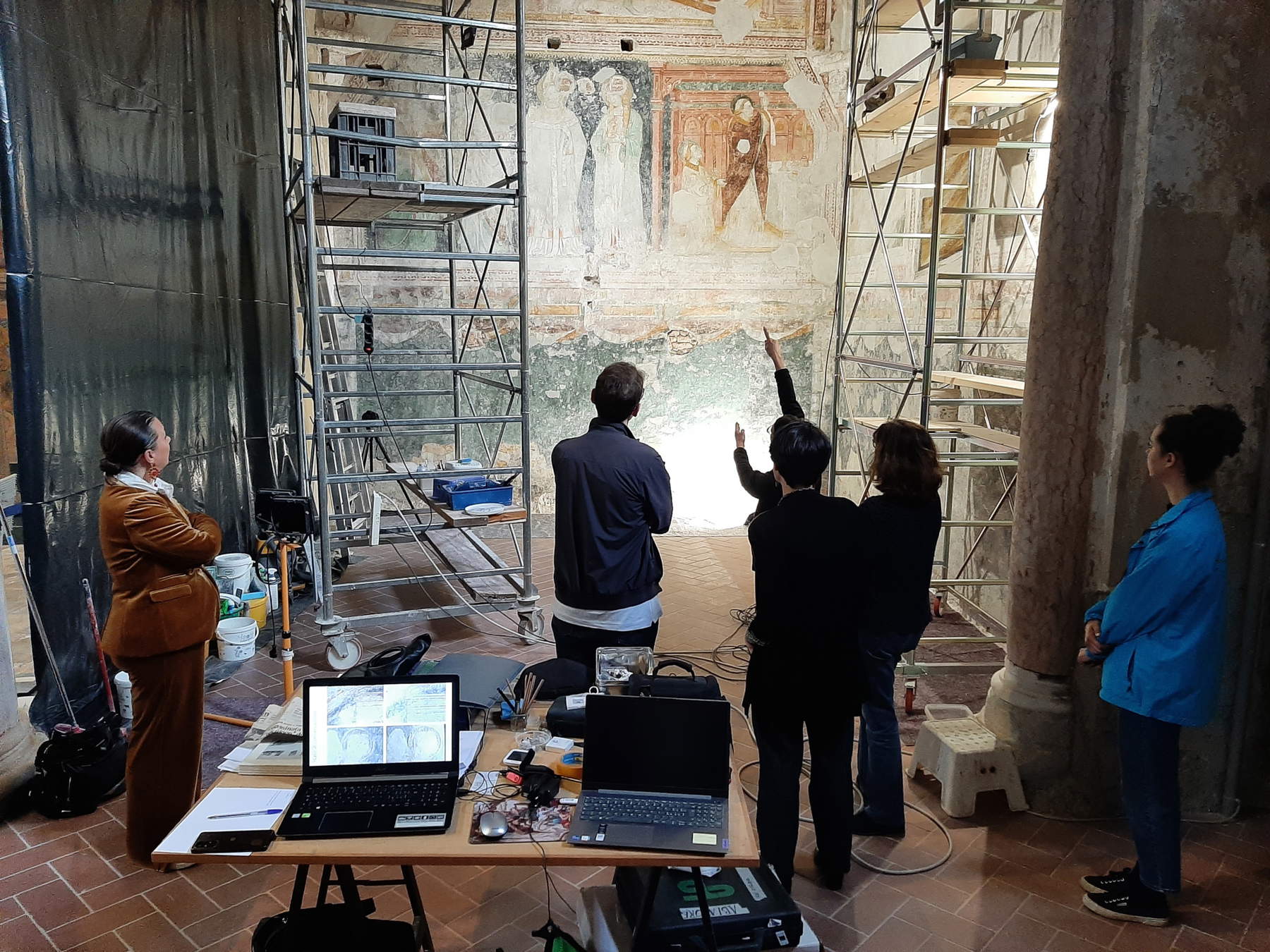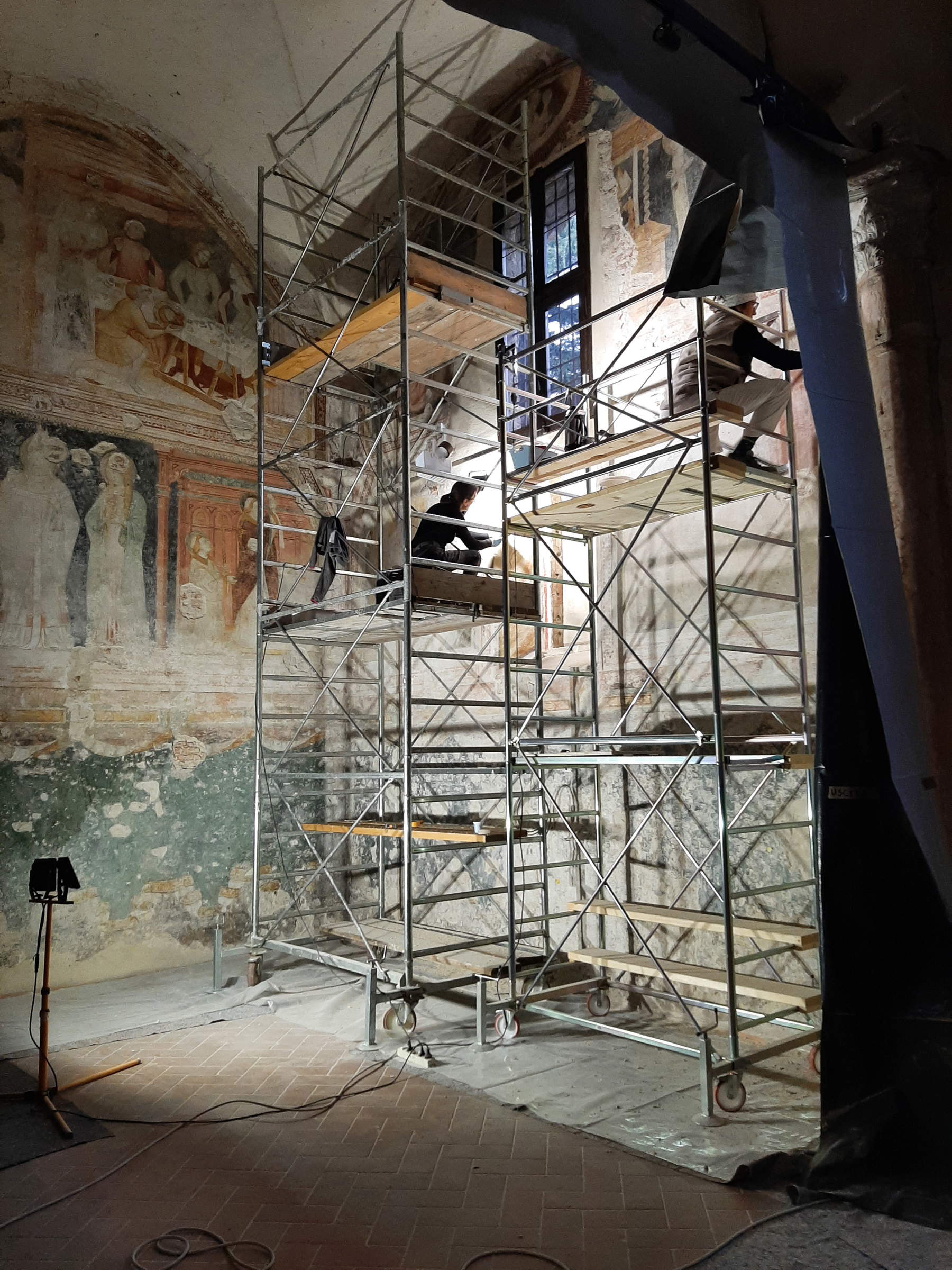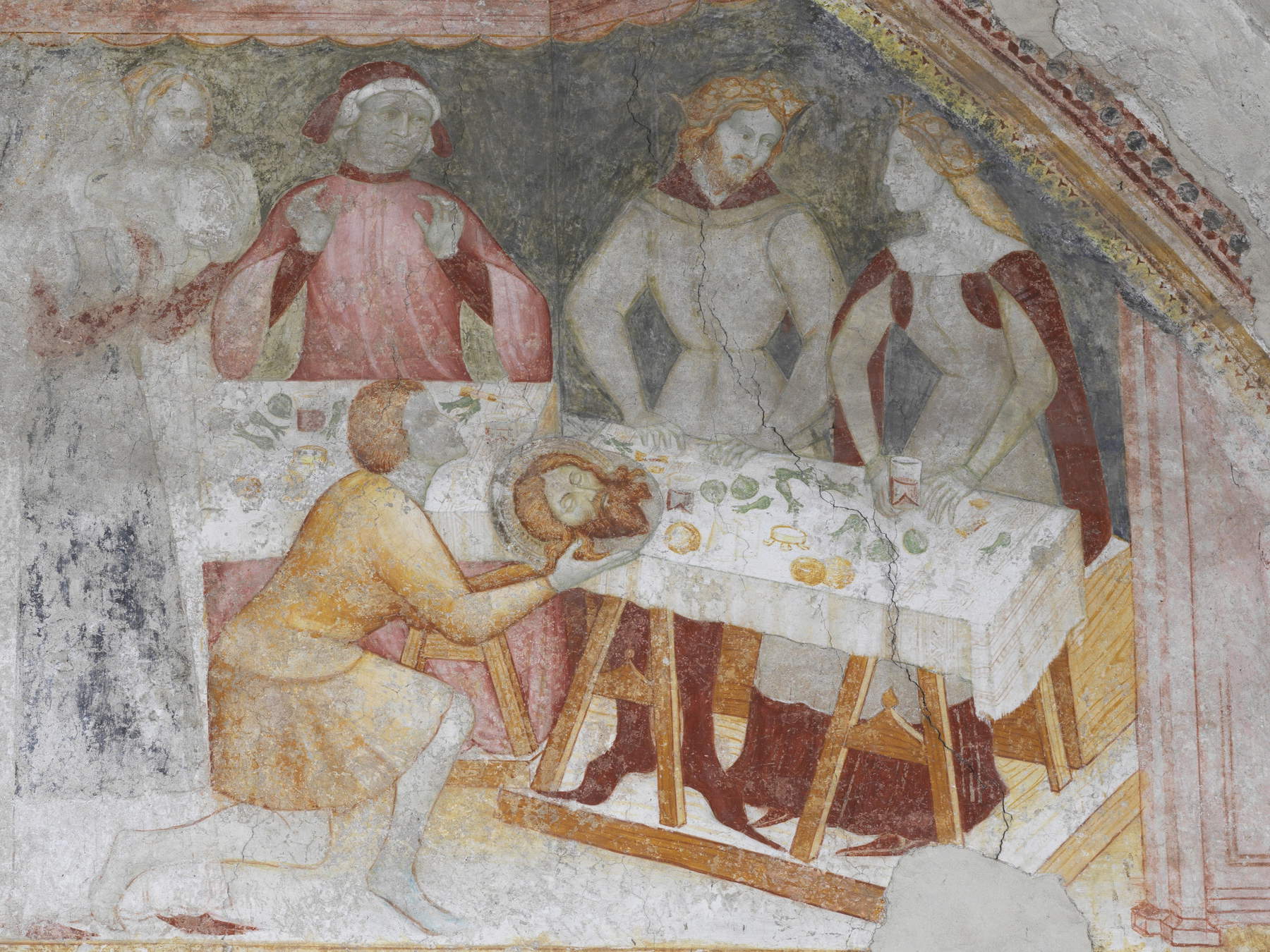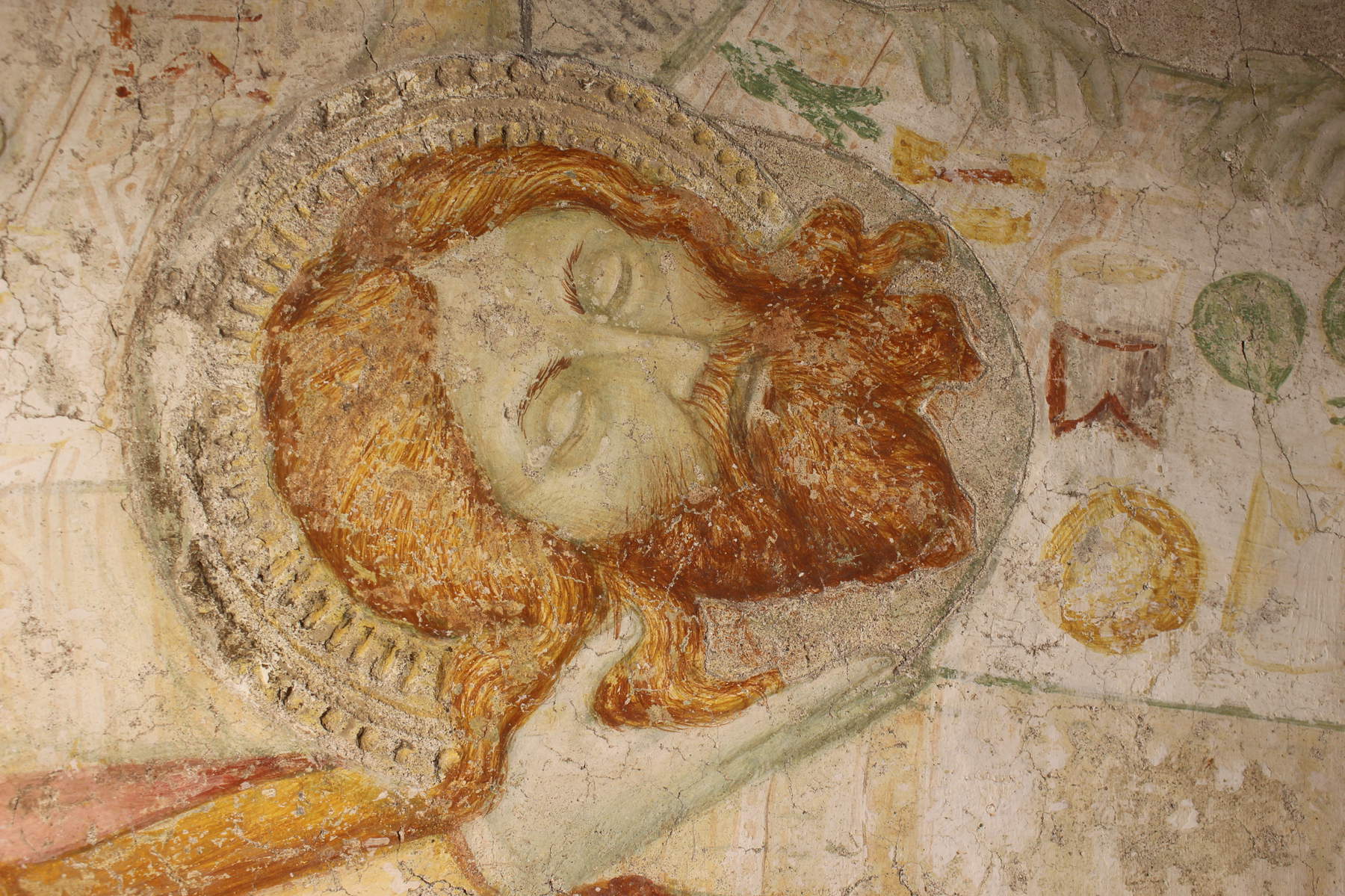In Brescia, restoration of the frescoes in the chapel of St. John the Baptist in San Salvatore, the Lombard basilica attached to the women’s monastery of San Salvatore, a UNESCO heritage site in Brescia and, since 2011, part of the serial site “The Lombards in Italy. Places of Power (568 - 774 AD).” This was announced by the Municipality of Brescia and the Brescia Musei Foundation.
Almost unknown to the general public, the chapel within the museum complex of Santa Giulia represents a unicum of 14th-century Brescian art. Probably the first to be annexed to the basilica in 1375, during the Visconti domination of the city, it was commissioned by Marcolo Petroni da Bernareggio, a wealthy Milanese linked to the monastery of Santa Giulia. The pictorial decoration was entrusted to the so-called Maestro di Lentate, a refined painter known today only to scholars, author, with his workshop, of the magnificent frescoes of the Oratory of Santo Stefano in Lentate, Brianza.
The restoration of the wall paintings, carried out by Fondazione Brescia Musei and entrusted to Studio Abeni Guerra, in constant dialogue with the museum management and the Collections and Research sector, coordinated by Roberta D’Adda, was was made possible thanks to the initiative of engineer Nicola Berlucchi, a member of the scientific committee of Fondazione Brescia Musei and an advocate, through the instrument of ArtBonus, of a fundraiser aimed at covering the cost of the restoration of the chapel also thanks to the donation of the design and direction of the work through his own Studio Berlucchi. Twenty-five thousand euros, in addition to the design, with which Fondazione Brescia Musei has been able to start this important process of enhancing the post-Longobard heritage of San Salvatore, a heritage of no less value than that of the early Middle Ages and which includes the chapel of Sant’Obizio, frescoed in the 1620s by Romanino.
The work, which began in January 2025 and was completed in May, included diagnostic investigations conducted by Vincenzo Gheroldi (professor of history and restoration techniques at the University of Bologna) with the support of Sara Marazzani, from which it emerged how rich the chapel must have been, and benefited from the presence as a collaborator in Fondazione Brescia Musei of scholar Roberta Castelnovo, a specialist in Art History at the Università Cattolica del Sacro Cuore and an expert on the Maestro di Lentate, who has conducted various research in the archives of the Musei Civici and the Soprintendenza Archeologia, Belle Arti e Paesaggio for the provinces of Bergamo and Brescia. In the wall paintings preserved in San Salvatore, the artist’s trait clearly emerges, blending typical Lombard naturalism with the culture brought to Milan in the 14th century, first by Giotto and then by Giusto de’ Menabuoi, with extremely precious results. Research is also focusing on the conservative history of the frescoes, as well as on the architecture of the chapel and, more generally, of the entire basilica, thanks to the vision of the diaries of the 1958 excavations (kept in the archives of the Civic Museums) from which the presence of tombs in the floor of the side chapels has emerged.
To explore the historical and artistic context of Brescia’s 14th century, Brescia’s Università Cattolica del Sacro Cuore, in collaboration with the Brescia Musei Foundation, is organizing the conference The Lion and the Viper: the Arts in Brescia in the 14th century. The event, curated by Professor Stefania Buganza and open to the public free of charge, will be held on May 22 and 23, 2025, with four sessions distributed between the University and the Civic Museums. Two will be hosted on the premises of Brescia Catholic University (the morning of Thursday, May 22 and Friday, May 23), two in the spaces of the Civic Museums: on the afternoon of Thursday 22, in the Conference Room of the Museo del Risorgimento Leonessa d’Italia, with a visit, to follow, to the frescoes of the Visconti donjon of the Brescia Castle, and on the afternoon of Friday 23, directly inside the basilica of San Salvatore, where talks dedicated to the chapel of San Giovanni and its restoration are planned. The morning of May 25, however, will feature guided tours of the chapel and frescoes, led by Roberta Castelnovo, in three shifts (10:15 a.m., 11 a.m. and 11:45 a.m.). The conference proceedings will be published in the Tipi di Fondazione Brescia Musei, within the series of studies edited by the city’s museum institution.
Starting May 25, an educational notebook, edited by the Educational Services of Fondazione Brescia Musei and coordinated by Federica Novali, will also be distributed free of charge, accompanying visitors to discover the iconography, customs and traditions of the time, through thematic fact sheets and detailed images of the frescoes.

All that we know today about the chapel of St. John the Baptist in San Salvatore is based on the fundamental research conducted in the 1960s by Gaetano Panazza, who was the first to link an epigraph, then on display in the Christian Museum, to the chapel. From this very inscription we learn that the chapel was dedicated in 1375 to St. John the Baptist at the behest of the Milanese Marcolo Petroni da Bernareggio.
Little is known about this personage, perhaps related to Beno Petroni, abbot and promoter of renovations in the church of San Vincenzo in Prato in Milan. It is certain, however, that he was rooted in Brescia, so much so that his wife Giovanna, by then a widow, was still living in the quadra of Santo Stefano (the Old Citadel) in 1388. He must have been deeply tied by economic or administrative reasons to the Monastery of Santa Giulia, since he managed to commission frescoes directly inside the basilica of San Salvatore and probably also to be buried inside it.
Of the epigraph, which was thought to have been lost for forty years, its location has recently been rediscovered in the deposits of the Civic Museums. In anticipation of the enhancement of the environment, it will be restored and once again placed in the exhibition itinerary. At the time the frescoes were painted, the chapel environment was likely fully decorated, including the vaults (which today are not the original ones) and the east wall, which was later demolished in the late 15th and early 16th centuries to make room for the nuns’ choir. Portions of the faux velarium along the wainscoting, a fragment of a scene in the upper register, elements of the cornice and a Holy Knight by the entrance wall still remain visible.
Identifying the architectural layout of the chapel remains complex, as the basilica of St. Savior has undergone various interventions over the centuries. It is conceivable that the chapel was originally isolated from the present adjacent chapels, which were built later.
The 14th-century paintings, which can be dated with certainty to 1375 thanks to the dedicatory plaque, were accidentally discovered in 1924 by restorer Aristide Malinverni under a thick layer of plaster. The descialbo was aggressively executed, causing the loss of entire portions and faces, which were later retouched by Malinverni himself, upon corrective intervention by superintendent Ettore Modigliani. New conservation interventions followed in the following years: between 1976 and 1977 Battista Giovanni Simoni carried out new consolidations and the tearing of the velarium in the wainscoting of the north wall, now preserved in the deposits of the Pinacoteca Tosio Martinengo; in 1980 it was the turn of Pierpaolo Cristani, who intervened again to stem the persistent conservation problems.
The pictorial cycle presents a complex iconography, articulated in two registers enclosed within architectural frames. At the bottom is a faux velarium with projecting corbels, while on the west wall the upper register develops the Stories of St. John the Baptist: on the left the Beheading, on the right - in a single composition - Herod’s Banquet, the Dance of Salome and the Delivery of the Head to Herodias. The middle register houses a theory of saints dear to the patron: from the left St. Andrew, St. Bartholomew, St. Ambrose, St. Mary Magdalene and the Mass of Saints, in which some scholars recognize St. Faustinus and Jovita. In the north lunette is the Annunciation, divided by the central lancet window, while in the lower register appear St. Peter and St. Paul on the left and St. Francis Receives the Stigmata on the right, barely visible today.
Attributed at first to a Lombard mastery, approximating the cycles of Visconti oratories such as Lentate, Mocchirolo and Albizzate, the frescoes were later assigned by Lavinia Galli to the so-called Maestro di Lentate and his workshop. This refined artist fused Lombard naturalism with the culture brought to Milan in the
14th century first by Giotto then by Giusto de’ Menabuoi. Examples are the meticulous details of the severed head of the Baptist, painted with extraordinary precision despite its height, and the accuracy of the table setting in Herod’s Banquet, where wood grain, the decorated tablecloth, figs, hazelnuts, wine-filled glasses and upside-down empty glasses stand out.
The Master of Lentate takes his name from the Oratory of Santo Stefano in Lentate, where he worked with his own workshop and other collaborators, producing, among others, the scene of St. George and the Dragon, the portrait of the patron Stefano Porro with his family, and the Stories of St. Stephen. His hand has also been identified in the Visconti Chapel in Sant’Eustorgio in Milan, where the theme of St. George reappears.
The recent restoration, conducted by Studio Abeni Guerra and preceded by extensive diagnostic investigations carried out by Vincenzo Gheroldi, has restored new legibility to the pictorial cycle, highlighting its original refinement. Indeed, the preliminary analyses carried out on the surfaces revealed the grandiose preciousness that must have characterized the entire chapel of St. John the Baptist and the very technique of the Master of Lentate. Traces of engravings were also identified, documenting the presence of metal foils. The removal of micro-traces of the drapery, which are still present, and the cleaning of the surfaces made it possible to enhance the remaining pieces of painting and to understand how much and what was lost. What remains of the cycle bears witness to a work of the highest quality, which only a prestigious patron, such as Marcolo Petroni, could commission from an artist as closely linked to the Visconti elite as the Master of Lentate.



 |
| Brescia, frescoes in the chapel of St. John the Baptist in San Salvatore restored |
Warning: the translation into English of the original Italian article was created using automatic tools. We undertake to review all articles, but we do not guarantee the total absence of inaccuracies in the translation due to the program. You can find the original by clicking on the ITA button. If you find any mistake,please contact us.